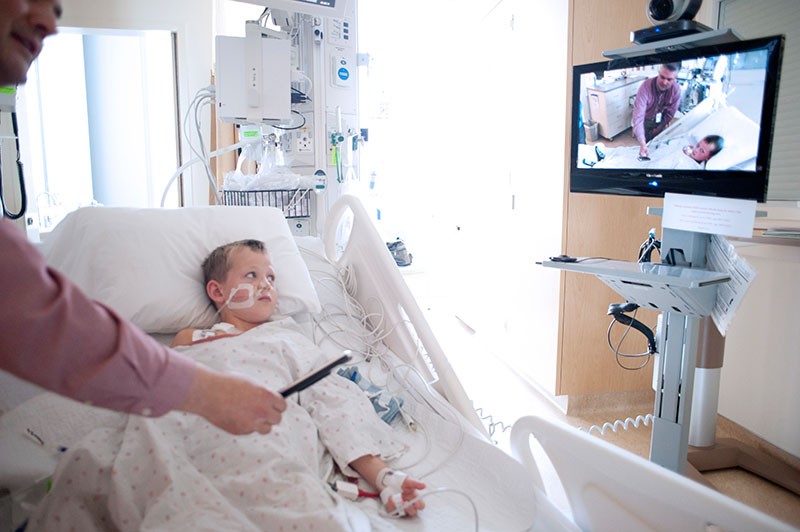Eighteen hours after his kidney transplant, Jay Lounsberry, 8, of Duluth, sat in an Amplatz ChildrenâÄôs Hospital bed last week and waited to thank his organ donor âÄî via video.
Kristi Lounsberry, JayâÄôs mother, punched in numbers on a remote control, and the television screen split into two windows. Jay saw his uncle TyâÄôs face, and although both patients were energy-sapped, they waved and Jay expressed his thanks.
ItâÄôs one example of âÄútelehealth,âÄù the use of teleconferencing for patients and doctors to interact or for patients to talk with family during long hospital stays. A University of Minnesota study may take telehealth a step further by pairing teleconferencing with care coordination âÄî juggling the appointments of patients who see many doctors and communicating across providers and health care systems.
School of Nursing professors Ann Garwick and Wendy Looman, two of the studyâÄôs clinical investigators, said they predict the model will result in fewer unnecessary doctorsâÄô visits and fewer accidental overlaps in clinical testing.
The care coordinator is one member of a medical team who acts as a liaison between the family, specialists, school nurses and other health care providers.
Few of the care coordinatorâÄôs services are billable, so one purpose of the University research is to quantify and justify the use of hospital resources to pay for a salaried care coordinator.
All children in the study are ages 2 to 15 with a complex health condition like asthma combined with autism and are undergoing long-term care at ChildrenâÄôs Hospitals and Clinics of Minnesota.
Nearly halfway into the four-year study, researchers have collected a yearâÄôs worth of data on early recruits, said Stanley Finkelstein, a University researcher and the principal investigator of the study.
A large chunk of the $2.1 million National Institutes of Health grant funding the School of Nursing study went to hiring Mary Erickson, a pediatric nurse practitioner with 30 yearsâÄô experience, to coordinate care for two-thirds of the 150 study participants.
The study has a control group receiving usual care from a registered nurse, and two experimental groups: one getting telephone care from Erickson, an advanced practice nurse âÄî a nurse with greater autonomy and knowledge than a standard registered nurse âÄî and one getting EricksonâÄôs care with the added benefit of teleconferencing equipment.
Families in the study form a long-term relationship with Erickson, who can write prescriptions, assess medical conditions and make referrals, reducing doctorâÄôs visits.
âÄúIn the video [conferences] you get the nonverbal communication,âÄù Erickson said. âÄúI get the gut sense it builds a higher level of trust.âÄù
In their homes, young patients have felt comfortable introducing their pets to Erickson, she said. She in turn gets to know their medical needs and history more intimately.
âÄúThe cost savings and efficiency is in only using my time instead of using multiple patient staff,âÄù Erickson said.
This model for complex conditions might also shorten the length of hospital stays and most importantly, they said, could take the burden of organizing appointments and sifting through medical records off of parents, thus improving their quality of life.
If Erickson is caring for a child with an infectious disease who needs to see a cardiologist, Looman said, Erickson might recognize that the child has all the necessary information on record from prior appointments to prevent redundant testing.
Dr. David Thorson, chairman of the Minnesota Medical AssociationâÄôs board of trustees, has been involved in pilot studies looking at other care coordination models and said the key quality of a care coordinator is interpersonal skills, rather than the training an advanced practice nurse has.
âÄúAre they over-trained for that care coordinator position? They probably are,âÄù he said.
Although the research might prove otherwise, Thorson said the added value of an advanced practice nurse does not justify the increased cost of the salary yet.
Erickson said she has enjoyed forming in-depth relationships with her patients in the project. Part of being a âÄúone-stop shopâÄù for families, as she calls herself, is being available for small questions as well as complex ones.
A mother participating in the study told Erickson she had been so focused on her childâÄôs medical care since his birth that she âÄúhad trouble being his mom.âÄù
âÄúNow she can just be his mom, instead of the provider,âÄù Erickson said.


